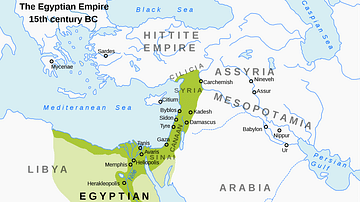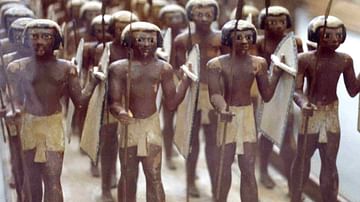
Xois (as the Greeks called it) was a vast ancient city located on a marshy island in the center of the Nile Delta of Egypt, modern-day Sakha. It was founded c. 3414-3100 BCE and was continuously inhabited until the rise of Christianity c. 390 CE. By the time of the Fifth Dynasty of Egypt (2498-2345 BCE), Xois was already regarded as an ancient city. It served as the capital of Egypt during the reign of the Hyksos in Egypt and was the site of the pivotal battle between Ramesses III (1186-1155 BCE) and the Sea Peoples with their Libyan allies in 1178 BCE.
Religious Center
It was a center of worship of the god Amon-Ra and was well known for the production of fine wine and luxury items. Known as Khasut or Khaset to the Egyptians, the island city is sometimes identified with No-Amon (traditionally a name ascribed to Thebes) mentioned in the biblical Book of Nahum where the Prophet Nahum warns the city of Nineveh of her pride and her coming destruction: “Art thou better than populous No, that was situated among the rivers, that had the waters round about it, whose rampart was the sea, and her wall was from the sea" (Nahum 3:8). That a famous city such as Nineveh should be compared to Xois testifies to the importance of the Egyptian city and the fame she enjoyed but, it should be noted, the Nahum passage has also been interpreted as referring to Thebes.
Amon was a god closely associated with Thebes who rose in prominence when the Theban prince Mentuhotep II (2061-2010 BCE) defeated his rivals and established Thebes as the capital of Egypt. Amon had existed previously, however, and Xois was one of the sites sacred to his worship. In the Delta region of Xois Amon was a fertility god and Ptah the creator god but this situation would change with the rise of Thebes as capital when Amon came to be seen as the supreme creator and giver of life, represented by the sun. Amon's wife, Mut, was the sun's rays and their son, Khons, the god of healing. Although these three deities are known as the Theban Triad, directly associated with Thebes, their veneration was spread through trade from Upper Egyptian cities like Thebes to those of Lower Egypt such as Xois.
Hyksos Rule & Xois as Capital
When the mysterious Hyksos people invaded Egypt in c. 1800 BCE, they subjugated the land and, by 1720 BCE, had rendered the Egyptian dynasty at Thebes a vassal state. Xois, then, became the competing center for rule in the land. The scholar John A. Wilson writes:
Some kind of rule continued at Thebes throughout the period, although for a time this rule was subordinated to that of the Hyksos. In addition, the beginning of the period may have seen a native Egyptian dynasty at Xois in the Delta competing with Thebes. Thus the pattern would be Theban dynasties throughout, perhpas a Xoite dynasty at the beginning, and Hyksos dynasties for the latter three quarters of the period. (158).
Wilson makes it clear that it is difficult to understand the significance of the city of Xois at this time owing to the absence of contemporary records. This same lack of records, of course, poses the long-standing difficulty in determining who the Hyksos were and where they came from. The city rallied after the defeat and expulsion of the Hyksos in 1555/50 BCE but declined in prestige. The nobles of Xois had founded the 14th Dynasty of Egypt at the city in 1650 BCE but, with the rise in power of Thebes after Ahmose I defeated the Hyksos, the dynasty collapsed and Xois declined in prominence. The Egyptian historian Manetho (3rd century BCE) listed 76 Xoite kings. Seventy-two of the names confirmed by the famous Turin King List papyrus are thought to have been prepared under Pharaoh Ramesses II (1279-1213 BCE). Although Xois was no longer the country's capital it continued as a prosperous trade center and place of pilgrimage. It would also become famous in Egyptian history as the site of the battle which drove off the final invasion of the Sea Peoples.
Ramesses III & the Battle of Xois
The city was one of the sites of the great defense of Egypt by Pharaoh Ramesses III against the Sea Peoples and their Libyan allies in the eighth year of his reign. The Sea Peoples had already tried to invade Egypt under the reign of Rameses II and his successor Merenptah (1213-1203 BCE) and were defeated in battle on the field; but Ramesses III understood he was facing a serious threat and could take no chances when it came to defense.
He chose a guerilla strategy over a field engagement and set up ambushes around the Nile Delta above Xois. Ramesses III lined the shores with archers who fired upon the ships as they tried to land troops. He then sent flaming arrows into the ships, setting them on fire, and crushing the invading forces.
Although Ramesses III was victorious in 1178 BCE, so costly was this war with the Sea Peoples that the royal treasury was depleted. This lack of funds, along with a mysterious drought, led to the first known labor strike in history (in the 29th year of the reign of Ramesses III) when expected provisions were not supplied to the elite tomb builders at the village of Set Maat (modern-day Deir el-Medina) and they walked off the job. This event is especially noteworthy because Set Maat was the village of the men who carved the famous tombs in the Valley of the Kings.
Vitality & Decline
Xois enjoyed prosperity as a center of worship and commerce for centuries after Ramesses III's famous victory. It was highly regarded as an ancient city of high culture and refinement over 2,000 years ago and maintained this reputation even after Egypt was made a province of Rome by Augustus in 30 BCE. Its long-standing fame as a production center for the best wine in Egypt helped maintain the city's wealth through the wine trade and ensured its vitality. The Romans developed a great appreciated for the wines of Xois and the city remained an affluent thouroughfare of commerce under Roman rule. It continued as a prosperous urban center until the coming of Christianity, after which it steadily declined. The historian Marc Van De Mieroop writes:
The rise of Christianity - which affected the entire Roman empire and beyond in the first centuries AD - may have had a more decisive impact on Egypt's culture...Although some ancient Egyptian concepts influenced the characteristics of Christianity in the country, many of the core ideas of the two cultures were incompatible. The exclusivity of the sole Christian god could not tolerate Egypt's vast pantheon, its sacred animals, and the like.
As Christianity took hold in Egypt, the ancient religious traditions which had made Xois a significant urban center were abandoned and, as drinking alcohol was frowned upon by the zealous adherents of the new faith, the demand for the wines of Xois fell off and the city had lost all of its resources and prestige by c. 390 CE. The pro-Christian edicts of the Roman emperor Theodosius I (reigned 379-395 CE), which closed pagan universities and temples, had an equally detrimental effect on cities and, among them, Xois. The city declined further until, by the time of the Muslim conquests of the 7th century CE, it was little more than a ruin occassionally occupied by nomads.





